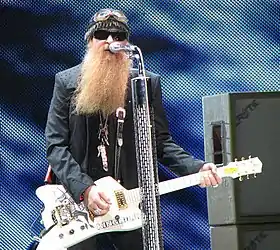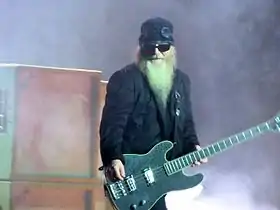ZZ Top equipment
This is some of the musical equipment used by the members of the hard rock/blues rock band ZZ Top.
Billy Gibbons

Guitars
Billy Gibbons' most novel guitar is the white spinning fur guitar made by Dean Zelinsky of Dean Guitars (and matching bass played by ZZ Top bassist Dusty Hill) featured in the 1983 "Legs" music video.[1] Gibbons described the mechanics of the spin:
"The guitars are attached to our belt buckles. It's a rotary electrical contact and strap mount. A hole is bored in the back of the guitar at the balancing point and the device is mounted there. Oh yeah, you gotta look out for that thing coming back around. Get your head and neck out of the way or else it'll say hello in an unfashionable fashion."
— [2]
Gibbons' choice of electric guitars has primarily been Gibson. His first guitar was a sunburst 1962 Gibson Melody Maker.[3] In 1968 Gibbons acquired the instrument most associated with the sound and style of ZZ Top, when he purchased a sunburst 1959 Gibson Les Paul Standard guitar from a farmer in Houston, Texas for $250. The guitar was named "Pearly Gates", a name taken from the dangerous-to-drive, rolling-wreck auto that he sold for the money to buy the guitar. This guitar has become the foundation/benchmark of every ZZ Top album since the group formed in 1969.[4]
Along with Gibson, Gibbons is also known for playing various Fender guitars. During his stint in the Moving Sidewalks, Gibbons used a white 1963 Fender Jazzmaster and Fender Esquire.[5] He has also used an extremely rare "Gretsch Jupiter Thunderbird" given to him by Bo Diddley. The use of this guitar (beginning with the 2003 ZZ Top album Mescalero) inspired a signature production model, the "Gretsch Billy-Bo Jupiter Thunderbird." For Mescalero, Gibbons also relied heavily on Ulrich Teuffel's futuristic Birdfish guitar, claiming it was second only to his 1959 Les Paul Sunburst Standard, "Pearly Gates". According to Gibbons, "It really shines on Mescalero because of that dirty, raunchy tone. I defy any other instrument, besides these odd-ball things, to get that crazy.“[6]
Gibbons has worked with Thomas Nilsen of Cream T Pickups to create the BFG Banger Humbucker Pickup. Billy has used these pickups live for the past decade.[7]
Amplifiers
Gibbons' sound is based on a 100-watt Marshall Super Lead made in 1968. According to an interview with music retailer Musician's Friend in 2008, Gibbons stated the importance of the Marshall Super Lead in ZZ Top's sound:
"I would say that it was the '59 Gibson Les Paul, better known now as 'Pearly Gates', plugged into a hundred-watt Marshall. [It] designed a sound that still resonates today."[8]
Along with the Super Leads, he has used a variety of Marshall's products, including the JCM 900 Dual Reverb,[9] Bluesbreaker, JTM45, Major,[10] and Lead 12.[9] Recently, his live touring rack consists of the JMP-1 Preamp, combined with power amps like the Valvestate 120 or the 9200 model.[11]
Gibbons has a large collection of vintage Fender amplifiers (his first amp was a Fender Champ), and collects Fender Dual Professionals. Other Fenders he has used include a Fender Bassman and Fender Tweed Deluxe.[12]
Gibbons now uses Magnatone amplifiers.[13]
At the 2010 Winter NAMM show, Dunlop Manufacturing and Gibbons unveiled a new line of guitar accessories, Rev. Willy's. These include Gibbons inspired picks, strings, and slides.[14]
Dusty Hill

Preferring the Fender Telecaster style bass, Dusty Hill also uses many different basses and amplifiers in different combos, and maintains a large collection of vintage as well as custom basses by noted luthier, John Bolin of Bolin Guitars USA. Hill is noted for designing simple, uncomplicated basses with a single pickup with a single volume knob, with the occasional addition of including a specially powered knob for tone control.[15][16]
See also
References
- Fanelli, Damian (April 11, 2018). "The Story Behind ZZ Top's Spinning Fur Guitars". Guitar World. Retrieved 5 April 2020.
- https://www.thestranger.com/seattle/sound-check/Content?oid=19094901
- Harward, Randy (24 February 2009). "Inquirer: Billy Gibbons - Guitar World". Guitar World. Archived from the original on 1 March 2009. Retrieved 25 August 2010.
- "Billy F. Gibbons" (PDF). The ToneQuest Report. Georgia: Mountanview Publishing. October 2002. p. 4. Retrieved 25 Aug 2010.
- "Billy F. Gibbons" (PDF). The ToneQuest Report. Georgia: Mountanview Publishing. October 2002. p. 3. Retrieved 25 Aug 2010.
- Guitar World, June 2003
- https://www.youtube.com/watch?v=731D191pmkk
- "Making Our December 2008 Cover - Billy Gibbons". Musician's Friend. December 2008. Retrieved 21 Aug 2010.
- Doyle, Michael (1993). The history of Marshall: the illustrated story of "the sound of rock". Hal Leonard. p. 25. ISBN 0-7935-2509-8.
- Paul, Alan (3 December 2009). "Prime Cuts: ZZ Top". Guitar World. Future US. Archived from the original on 26 March 2011. Retrieved 21 August 2010.
- Prown, Pete; Lisa Sharken (2003). Gear Secrets of the Guitar Legends: How to Sound Like Your Favorite Players. Hal Leonard Corporation. p. 119. ISBN 0-87930-751-X.
- Pittman, Aspen (2003). The Tube Amp Book. Hal Leonard. p. 165. ISBN 0-87930-767-6.
- "Bringing Back The Magnatone" (PDF). The Music Trades. 164 (1). February 2016. Retrieved 25 April 2019.
- "Dunlop's NAMM 2010 Accessories Demo Video". Dunlop Manufacturing. Retrieved 3 May 2010.
- "Dusty Hill Biography". Archived from the original on 2012-06-22.
- "Hollowbody Bass Archive » Dusty Hill of ZZ Top". Hollowbody Bassist. Archived from the original on 2010-09-04. Retrieved 2010-12-26.